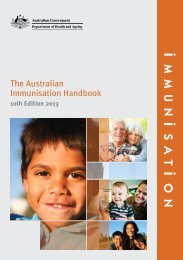3.30 MB - Academy of Medicine of Malaysia
3.30 MB - Academy of Medicine of Malaysia
3.30 MB - Academy of Medicine of Malaysia
You also want an ePaper? Increase the reach of your titles
YUMPU automatically turns print PDFs into web optimized ePapers that Google loves.
MANAGEMENT OF HIV INFECTION IN CHILDREN<br />
In a retrospective case-control study among adults from Spain 117, Level 6 , ART<br />
and PPV were found to have a significant, independent protective effect<br />
against pneumococcal disease, regardless <strong>of</strong> CD4 lymphocyte count. It was<br />
therefore concluded that all patients (adults) with HIV infection should be<br />
vaccinated with PPV vaccine to prevent pneumococcal disease.<br />
Table 1: Pneumococcal Vaccination Schedule for Children at Special Risk<br />
Age<br />
Conjugate<br />
vaccine<br />
Polysaccharide<br />
vaccine<br />
2-6 months 7-11 months 12-23 months<br />
3 doses, 2 doses,<br />
monthly intervals monthly intervals<br />
Further dose in second year <strong>of</strong> life<br />
Then after 2 nd birthday single dose <strong>of</strong> 23-valent<br />
When both conjugate and polysaccharide vaccines are used, the polysaccharide vaccine should be<br />
given at least two months after the last dose <strong>of</strong> conjugate vaccine<br />
h) Meningococcal vaccine<br />
So far, there are no data available on the response <strong>of</strong> HIV infected infants<br />
and children to meningococcal polysaccharide or conjugate vaccines.<br />
i) Varicella vaccine<br />
This is a live-attenuated vaccine. The vaccine is safe and thus far, no<br />
increase in adverse reactions compared to normal controls have been<br />
noted. 118, Level 6; 119, Level 6 However, the studies on safety excluded those with<br />
severe immunosuppression. The vaccine induced good immunogenicity in<br />
HIV infected children with 60-79% developing protective antibody 2 months<br />
after completion <strong>of</strong> 2-dose vaccination.<br />
j) Human Papilloma Virus Vaccine<br />
There is evidence that infections with higher risk human papillomavirus<br />
(HPV) sub-types are more common in HIV infected girls aged 13-19 years than<br />
in HIV non-infected girls <strong>of</strong> the same age. The rates <strong>of</strong> squamous intraepithelial<br />
120, Level 2<br />
lesions were significantly higher in the HIV infected girls.<br />
The HPV vaccine is indicated in girls and women 9 to 26 years <strong>of</strong> age for<br />
the prevention <strong>of</strong> cervical cancer, precancerous or dysplastic lesions, and<br />
genital warts caused by HPV Types 6, 11, 16, and 18. No recommendations<br />
have been made regarding the use <strong>of</strong> HPV vaccinations in HIV-positive<br />
individuals. Clinical trials are currently underway to assess the safety and<br />
efficacy <strong>of</strong> the vaccine in individuals with HIV. It should be noted that the<br />
candidate vaccines are preventive rather than therapeutic, the benefits <strong>of</strong> the<br />
vaccine in individuals who have already been exposed to HPV are doubtful.<br />
121, Level 2<br />
14<br />
2 doses,<br />
2 months apart

















